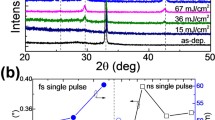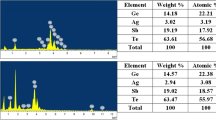Abstract
The crystallization of amorphous Ge2Sb2Te5 phase change material induced by electron beam irradiation was investigated by in-situ transmission electron microscopy (TEM). Amorphous matrix transformed into a partially crystalline state after being irradiated with a 200-keV electron beam for a long time. Real-time observation revealed that the crystallization of amorphous Ge2Sb2Te5 film occurs through a nucleation and growth mechanism under electron beam irradiation in TEM. While uncertainty from the 2D projection remains, the nuclei have been observed to grow preferentially along the < 100> direction.
Similar content being viewed by others
Transmission electron microscopy (TEM) is a powerful tool for analyzing phase change materials and provides localized information about the microstructures. However, high energy electron beam irradiation may affect the kinetics of phase transformation in the chalcogenide materials (Nagase et al., 2004; Kooi et al., 2004; Zhou et al., 2018). (Zhou et al., 2018) investigated the phase change mechanism for chalcogenide materials using in-situ heating TEM and selected area electron diffraction, and reported that Ge2Sb2Te5 is a nucleation-dominated material, while Si2Sb2Te3 and Ti0.5Sb2Te3 are growth-dominated materials. However, the electron beam irradiation induced crystal growth behavior such as a preferred growth direction of crystalline Ge2Sb2Te5 has not been reported.
In this work, the crystal growth behavior of amorphous Ge2Sb2Te5 material induced by electron beam irradiation is demonstrated using in-situ TEM (JEOL JEM-ARM200F) operated at 200 kV. The figure shows high-resolution TEM (HRTEM) images and Fast Fourier Transformed (FFT) diffractograms in the inset for the amorphous Ge2Sb2Te5 film subjected to 200 keV electron beam irradiation. The HRTEM images show the microstructural evolution of amorphous Ge2Sb2Te5 film after electron beam irradiation for t = 0, 10, 24, 40, 41, 45, and 48 min, where t refers to the time elapsed after the start of electron beam irradiation. Firstly, initial Ge2Sb2Te5 film was amorphous phase, which was confirmed by a halo-ring pattern in FFTs as shown in Fig. 1a. After the electron beam irradiation for 10 min, small nuclei with a diameter of 6.0 nm was observed in the Ge2Sb2Te5 film and few diffracted spots were simultaneously found in the FFTs (Fig. 1b). The nucleus indicated by the red arrow was observed to grow in a regular atomic arrangement by electron beam irradiation for a period of 24 to 48 min (Fig. 1c-g). From direct observation using in-situ TEM, it was confirmed that the crystallization of the Ge2Sb2Te5 film induced by electron beam irradiation was a nucleation-dominated process, consistent with the previous work (Zhou et al., 2018). Further HRTEM analysis revealed the lattice structure and the preferred growth direction of the crystallized grains. As shown in figure (Fig. 1h), facets were developed in front of the growing fcc crystal grain and were parallel to {110} planes according to the result of phase analysis using HRTEM image and FFT in the inset. However, 2D projection of a cube in the < 111> direction can create 6 cube edges which are parallel to the {110} planes as shown in figure (Fig. 1i). The facets can be either {100} or {110} because of the projection artifacts. In other words, the determination of the growth direction based on a single electron diffraction pattern or HRTEM image may leave some degree of uncertainty. Nevertheless, the facet is most likely to be {100} rather than {110} due to the lower surface energy of the {100} plane.
Consequently, crystallization of amorphous Ge2Sb2Te5 film occurs through a nucleation dominated mechanism under electron beam irradiation in TEM, and the nuclei preferentially grow along the < 100> direction, developing {100} facets.
Availability of data and materials
Not applicable.
References
B.J. Kooi, W.M.G. Groot, J.T.M. De Hosson, In situ transmission electron microscopy study of the crystallization of Ge2Sb2Te5. J. Appl. Phys. 95, 924 (2004)
T. Nagase, Y. Umakoshi, Electron irradiation induced crystallization of the amorphous phase in Zr65.0Al7.5Ni10.0Cu17.5 metallic glass. Sci. Technol. Adv. Mater. 5, 57–67 (2004)
D. Zhou, L. Wu, L. Wen, L. Ma, X. Zhang, Y. Li, Q. Guo, Z. Song, Electron-beam-irradiation-induced crystallization of amorphous solid phase change materials. Jpn. J. Appl. Phys. 57, 041401 (2018)
Acknowledgements
This work was supported by the Ministry of Trade, Industry & Energy (MOTIE) [project number 10080625], the Korea Semiconductor Research Consortium (KSRC) support program for the development of future semiconductor devices, and Samsung Electronics.
Funding
This work was supported by the Ministry of Trade, Industry & Energy (MOTIE) [project number 10080625], the Korea Semiconductor Research Consortium (KSRC) support program for the development of future semiconductor devices, and Samsung Electronics.
Author information
Authors and Affiliations
Contributions
BSA have contributed to producing experimental resources, data acquisition and TEM analysis and to writing the manuscript. The author read and approved the final manuscript.
Corresponding author
Ethics declarations
Competing interests
The author declare that he has no competing interests.
Additional information
Publisher’s Note
Springer Nature remains neutral with regard to jurisdictional claims in published maps and institutional affiliations.
Rights and permissions
Open Access This article is distributed under the terms of the Creative Commons Attribution 4.0 International License (http://creativecommons.org/licenses/by/4.0/), which permits unrestricted use, distribution, and reproduction in any medium, provided you give appropriate credit to the original author(s) and the source, provide a link to the Creative Commons license, and indicate if changes were made.
About this article
Cite this article
An, BS. Electron beam irradiation induced crystallization behavior of amorphous Ge2Sb2Te5 chalcogenide material. Appl. Microsc. 49, 17 (2019). https://doi.org/10.1186/s42649-019-0021-5
Received:
Accepted:
Published:
DOI: https://doi.org/10.1186/s42649-019-0021-5





